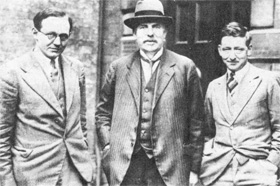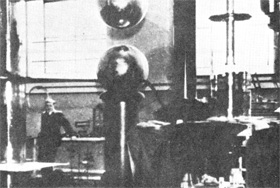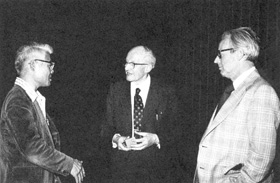Accelerator Pioneer Visits Fermilab
Ernest T.S. Walton, 1951 Nobel laureate, visited Fermilab last week. The Irish physicist is spending six months in the United States as a guest of North Texas State University. It was his first visit to Fermilab where the modern version of the "Cockcroft-Walton" provides the source of particles for the Fermilab accelerator system. It was the first such machine developed by Walton and John Cockcroft in the early 1930's that became the world's first particle accelerator.
At a colloquium for his Fermilab colleagues, Dr. Walton described the one hundred years of the Cavendish Laboratory at Cambridge that began under the 7th Duke of Devonshire in 1870 and has been marked by the presence of some of the greatest names in scientific history. At least 22 Cavendish scientists have been awarded Nobel prizes, he pointed out. Among these were James Clerk Maxwell, John W. S. Rayleigh, and J. J. Thompson.
Dr. Walton recalled the era of the direction of Cavendish by Lord Ernest Rutherford, particularly the seven years before 1934 when "Rutherford was at his height," according to Dr. Walton. It was Lord Rutherford's research in the early 1900's that revealed the nucleus of the atom.
"Rutherford was a man of great scientific caution," Walton recalled. "He had a great love of alpha particles. He seemed to think he had some special rights to them. It was true that they all came out at the same energy and could be counted by simple methods. I think Rutherford's character was somewhat the same as the alpha particle which always goes straight, bulldozing through matter. And so did Rutherford bulldoze through an experiment to the objective.
"Rutherford was very impatient if new results were coming; he couldn't wait," according to Dr. Walton. "He carried short blunt pencils which he frequently used to mark up preliminary data so badly that it was ruined. As a result, his underlings developed all sorts of subterfuges to keep information from him until it was ready."
Walton said that Rutherford insisted that young students get into research that was of special interest to them. It was Rutherford's encouragement that led Walton to seek a way to produce particles for research. John Cockcroft joined the project that led to the development of the important source of ionized particles.
Dr. Walton toured the Fermilab facilities as the guest of Fermilab physicist Don Edwards. Stopping in the gallery of Fermilab's pre-accelerator for a photograph, he was asked to give his impression of Fermilab's addition to high energy physics facilities:
"I find it very interesting. In my mind I compare it with the early accelerator which we created at the Cavendish Laboratory. You have an impressive professionally-made machine. Ours was a crude home-made bit of equipment which we somehow managed to keep running long enough and sufficiently well to do our experiments."






